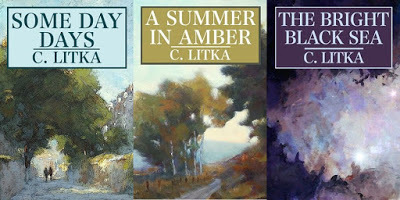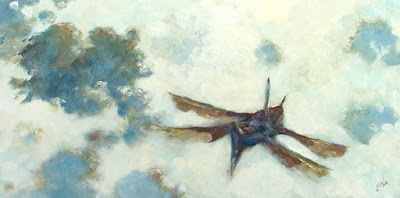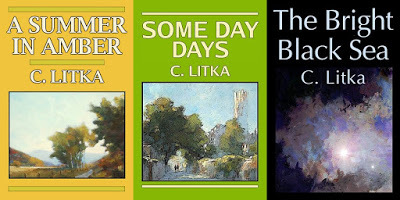C. Litka's Blog, page 69
January 29, 2016
Alpha Ver. Hissi, K'raya, Py, and the Mountain of Gold completed
 I'm happy to say that I completed the alpha version of Hissi, K'raya, Py and the Mountain of Goldthis morning – a 63,000 word section which includes three adventures, tied together by characters and place. The title is just the new working title of Slaver, Saint and the Bargemen of Daerithat I posted about early in December. It will be the second of three parts that make up The Lost Star's Sea (Vol 1). With it, we're 124,000 words into the story with one more section to write, and everything to revise and work into shape. Still, if all goes well, I should be able to write the third section, and revise the complete work in time to be published by late summer or early fall 2016, which would be a year after the Bright Black Sea was released. That said, I must admit that I have only a vague idea of what adventures and dangers Wil Litang encounters next. (Though I know how it ends.) But without words on paper, I can't promise any firm release date. I still have a lot of day dreaming to do. If I should find myself bogged down, I may still go with my original idea which was to publish these parts as a series of episodes until the complete work is finished. We'll see how the next few months pan out.
I'm happy to say that I completed the alpha version of Hissi, K'raya, Py and the Mountain of Goldthis morning – a 63,000 word section which includes three adventures, tied together by characters and place. The title is just the new working title of Slaver, Saint and the Bargemen of Daerithat I posted about early in December. It will be the second of three parts that make up The Lost Star's Sea (Vol 1). With it, we're 124,000 words into the story with one more section to write, and everything to revise and work into shape. Still, if all goes well, I should be able to write the third section, and revise the complete work in time to be published by late summer or early fall 2016, which would be a year after the Bright Black Sea was released. That said, I must admit that I have only a vague idea of what adventures and dangers Wil Litang encounters next. (Though I know how it ends.) But without words on paper, I can't promise any firm release date. I still have a lot of day dreaming to do. If I should find myself bogged down, I may still go with my original idea which was to publish these parts as a series of episodes until the complete work is finished. We'll see how the next few months pan out. Long term, I'm thinking The Lost Star's Sea will be published in two volumes. In this first one, Wil Litang is introduced to the Archipelago of the Tenth Star, and slowly finds a new life within it. In the second volume, we'd then shake his life up again, challenging his decisions and perhaps bring back the unresolved story threads from the Bright Black Sea to be resolved, as well as mysteries introduced in volume 1. That said, I have no idea what this all means in terms of a story. Nothing has been determined as to where it goes and how it ends up, which is one reason why I'd like the first volume to be able to stand on its own, if need be. It may be some years before I tackle volume 2.
One of the great disadvantages to doing a sequel is that its readership is almost entirely limited to people who've read the previous book. Reading the Bright Black Seawill be essential to The Lost Star's Sea. While I'm very happy with how The Bright Black Sea has been received, both in terms of downloads and in reader reviews, we're not talking tens of thousands of downloads yet, so the sequel will appeal to a fairly narrow readership of The Bright Black Sea readers. It is possible that a new release might renew interest in the first book, but I'd not count on it. In any event, this is one of the reasons why I'd like to write something a little different now. I'd like to see if I could expand my readership by writing something that might appeal to people who don't read science fiction. Fantasy is actually more popular than science fiction these days, so I'd like to take a crack at that market as well.
All of which is to say that I plan to take some time away from Wil Litang. Perhaps just a week or maybe a month to make a start on that Edwardian fantasy idea I've been toying with for some time. I now have settled on the nose of a story, which might actually lead to more of the shaggy story that goes with the nose. I'm planning to get this first chapter down, develop the main character a bit and set the stage for a story, if only to prime the pump and see where the nose leads to next. Right now, I'll admit, I don't really have a story yet. But I do have a title, which is half the battle – Here & There, an Odd Door. I'm into weird titles at the moment, I guess. The basic idea is that the fabled Otherworld is closer than you think and that there are doors to it, you just don't see them. Not unless you have a key... I think I'll set it in London and England around 1910, though it may not be the London and England of our history. We'll see. It's all still up in the air. I've worked on my other stories all together, one way or the other, so I don't see that if I end up working on two stories – if I'm lucky enough to be able to have two stories to work on – that it would be a problem. Stay tuned.
Published on January 29, 2016 06:41
January 7, 2016
Slaver, Saint and the Bargemen of Daeri
 Haven't had much success coming up with the fantasy story yet – just a glimmering – so I'm continuing on with the next Wil Litang novel. Right now it looks like first of two volumes of The Lost Star's Sea, chronicling Wil's initial (mis)adventures within the Archipelago of the Tenth Star will consist of three sections. The first, Cin, Siss, and the Pirates of Temtre is done in first draft. I'm in the middle of the second section, Slaver, Saint, and the Bargemen of Daeri, which, with luck I'll have done by the end of the month, or the next. The third section I have vague plans for, but no definite plot yet. Still, I have time. If I can get that one done this winter as well (hate to waste all these dreary days trapped in the house) then I'll look to have the complete The Lost Star's Sea, Vol. 1 out late summer or fall of 2016. A novel a year looks to be about my pace, in a good year.
Haven't had much success coming up with the fantasy story yet – just a glimmering – so I'm continuing on with the next Wil Litang novel. Right now it looks like first of two volumes of The Lost Star's Sea, chronicling Wil's initial (mis)adventures within the Archipelago of the Tenth Star will consist of three sections. The first, Cin, Siss, and the Pirates of Temtre is done in first draft. I'm in the middle of the second section, Slaver, Saint, and the Bargemen of Daeri, which, with luck I'll have done by the end of the month, or the next. The third section I have vague plans for, but no definite plot yet. Still, I have time. If I can get that one done this winter as well (hate to waste all these dreary days trapped in the house) then I'll look to have the complete The Lost Star's Sea, Vol. 1 out late summer or fall of 2016. A novel a year looks to be about my pace, in a good year.
Published on January 07, 2016 13:07
December 30, 2015
New Covers for 2016
 For 2016 I worked up some new covers for my books. I used the same art (my own) but reversed the priorities – putting the titles in the box and letting the art fill the cover. I'm thinking they're an improvement. At least I've eliminated that black outline around the text of A Summer in Amber that was problematical in the thumbnail images.
For 2016 I worked up some new covers for my books. I used the same art (my own) but reversed the priorities – putting the titles in the box and letting the art fill the cover. I'm thinking they're an improvement. At least I've eliminated that black outline around the text of A Summer in Amber that was problematical in the thumbnail images. Everything I read about self-publishing says you need professionally designed covers. You should make your cover look like the covers of other, professionally designed books in your genre because people judge the quality of the book by the quality of its cover. I have to admit I do as well. That said, I can't say I'm all that impressed with many of the presumably professionally designed covers I see. Possibly because they all look alike. Since I'm not writing my stories to be just like other stories in their genre – I'm writing the stories I can't find to read – I think my covers should reflect their outlier nature. And since my stories are rather old fashioned, I think my covers should suggest that too. Which, at any rate, is my story, and I'm sticking with it. That, and the fact that my cover budget is $0, so cover design, as well as everything else, must be done in-house.
Published on December 30, 2015 18:30
December 7, 2015
Cin, Siss, and the Pirates of Temtre
 Cin, Siss, and the Pirates of Temtre is the first episode in the planned companion volume for The Bright Black Sea, tentatively titled The Lost Star's Sea. It will chronicle the (mis)adventures of Captain Wil Litang in the Archipelago of the Tenth Star. The Bright Black Sea took something like four years to write and I don't anticipate that The Lost Star's Sea, likely just as long, will be written any faster. As of now I'm 65 years old, and can't count on tomorrow, much less four years from now, so I'm planning to release the beta versions of each episode as I produce them. I use the terms "alpha" and "beta" rather than first and final drafts because I haven't a clue as to where the story will end up, and I may well need to go back and make minor alterations in an episode or two to make things come out the way they should in the end. Thus, the individual episodes should be considered somewhat tentative until they are rolled into The Lost Star's Sea. 70,000 years and uncounted lightyears away make transcribing Wil Litang's account a sometimes iffy venture.
Cin, Siss, and the Pirates of Temtre is the first episode in the planned companion volume for The Bright Black Sea, tentatively titled The Lost Star's Sea. It will chronicle the (mis)adventures of Captain Wil Litang in the Archipelago of the Tenth Star. The Bright Black Sea took something like four years to write and I don't anticipate that The Lost Star's Sea, likely just as long, will be written any faster. As of now I'm 65 years old, and can't count on tomorrow, much less four years from now, so I'm planning to release the beta versions of each episode as I produce them. I use the terms "alpha" and "beta" rather than first and final drafts because I haven't a clue as to where the story will end up, and I may well need to go back and make minor alterations in an episode or two to make things come out the way they should in the end. Thus, the individual episodes should be considered somewhat tentative until they are rolled into The Lost Star's Sea. 70,000 years and uncounted lightyears away make transcribing Wil Litang's account a sometimes iffy venture.Cin, Siss, and the Pirates of Temtre, is a short novel length, 60,000+ word, episode that serves as a bridge between this new novel and The Bright Black Sea. The Bright Black Sea was written as an ode to the golden and pulp age writers of science fiction. In The Lost Star's Sea I'm setting out to write a fond tribute to only one of them – Edgar Rice Burroughs. In the Archipelago of the Tenth Star I have a vast stage filled with strange and wild creatures, savage and advance peoples, swords and sails, mysteries and dangers at every turn that must be faced and if not conquered, survived. I intend, to give those old stories some new twists – I rather doubt any damsels in these tales will need rescuing. Litang, on the other hand... Well, as I indicated, I really don't know where the story will lead us. I have plot elements hanging from The Bright Black Sea to work with, and have tossed in other possibilities as well in this episode, but where they'll lead is anyone's guess. I have ideas where Litang will end up in the next two episodes, but after that, well, I'll just have to wait and see what develops.
I may tinker with this alpha version over the next two weeks, but I plan to put it away until April or May 2016. By then I should be able to approach it bright eyed and bushy tailed, and with the story down, devote myself to crafting the words to make the story as entertaining as I can. Revisions are always more fun than getting the story down the first time, so the heavy lifting is done. If all goes well, I'll release the episode sometime late May or June 2016.
In the meanwhile, I'm hoping to at least get a start on a completely new novel, a fantasy set not in some medieval world, but in a sort of Edwardian age. Motor cars, trains, and the arcane arts of a lost age. We'll see if I can get that to lift.
Published on December 07, 2015 17:24
December 5, 2015
NEW! Ver. 2.0 of The Bright Black Sea Now Available
The Bright Black Sea Version 2.0 is now available on Smashwords and Amazon. It will be available on iBooks and Barnes & Noble within the next few days.
Ver. 2.0 brings many "bug fixes", hopefully addressing concerns expressed in some early reviews. I moved the file from a Mac to a Windows machine and a newer version of LibreOffice, which then highlighted many typos and questionable words that the old version had not. Whether this is the result of LibreOffice being a newer version or that over the years of working in the old program many words may've somehow gotten into the program's dictionary and so weren't highlighted, I can't say. I do think that this is a significant update for everyone, and especially if you are just now starting to read a version released before 5 Dec 2015. Not only does it corrected misspellings, eliminate extra spaces and correct punctuation, but I've also straightened out several dozen awkward sentences, improved the constancy of names, made some minor clarifications, and restored "then" to the work.
Some how – no doubt operator error, since it's always operator error – while using the "find and replace" function of the program without a word in the "replace" box to check the usage of "then" (after the work had been proof-read), I must've hit "replace all" instead of "done". As a result, every "then" in the document was replaced with a space. Murphy's Law in action – if something can go wrong, it will. Hopefully, I've now restored those missing "then"s.
This work was written over the course of some four years and the decision to publish it was made only towards the end of the process. Going forward with new works, and with the knowledge that I will be publishing these works, I hope to use the lessons I've learned the hard way and have a process in place from day one that will eliminate these errors prior to publication, producing a cleaner copy out of the starting gate.
That said, there will likely always be some typos. Writing and editing/proof reading are two different professions, and I'm not an editor/proof reader. Professional proof readers charge between $.02 to $.03 a word and editing can jump the bill to $.04 a word. There are about 327,500 words in The Bright Black Sea. If you do the math you'd see that it would cost between $6,550 and $9,825 to have this book professionally proof read, and up to $13,100 to be professionally edited. There is simply no combination of price & sales volume that could ever be expected to produce enough royalties to cover even a tiny faction of this expense for an independently published writer like myself without a large established base of readers. I've read that 95% of indie published works fail to cover their expenses. And I know that it is very common for new authors to be able to count their sales on the fingers of their two hands and put a name to almost every sale as well. By forgoing professional covers, proof reading and paid promotions, I can at least break even with a cover price of free. The actual price of the work, however, will be typos. I will continue to try improve my processes to make that price as small and as painless as possible as well.
To upgrade to the new version you will need to:
Smashwords versions will probably have to be re-downloaded. It's live now.
iBooks versions include a "update" button that should update the book to the newest version when it becomes available.
Amazon versions is also live at this posting. I think it can be updated by going to a "Manage your Devices" page and turning on automatic updates. I downloaded the earlier version of this work, and have switched that option on, (it was off by default) so we'll see how it works. In the past I tried eliminating the old version on the device and even from my account, and then re-download the book again only to still get the old version. I'll post more when I know what'll work.
Barnes & Noble versions, haven't a clue. I don't have a B & N account.
Kobo. Doesn't apply to anyone that I know of to date.
Published on December 05, 2015 14:45
November 15, 2015
New Bio
Playing around with a new bio to spice up my various author pages. Below is the current draft.
Chuck Litka, who signs his stories and paintingsC. Litka,plies his art as an amateur, which is to say, for pleasure rather than profitso henever has to wonder Will this sell? He has dreamed of writing science fiction since his distant youth, but his intrinsic inability to spell English, together with a certain lack of persistence doomed his early efforts to doorstops.
He attended the University of Wisconsin earning a BA in International Relations, and a BS in Agronomy. He worked for several government agencies, stocked shelves in grocery stores, and spent 13 years inpre-press as the printing industry moved from manual to digital, ending up as a graphics tech for a smalldaily newspaper before giving it all up to paint.He lives with his wife in rural Wisconsin. Weather permitting,he rides his bike for several hours a day, occasionally tends a small garden and mows his lawn once a week. Unless it doesn't need it.Come now, Chuck, we'll need a little more than that.And no, I can'tjust make stuff up. Abio is not a work of fiction.He bakes his own sour dough bread, and drinks four mugs of tea a day – loose leaf, not tea bags.Great, that added 21 words and a great deal of excitement. Yes, I'm being sarcastic. How about travel? Travel's always material good for a bio.Mr Litka spent several months traveling from Wick to Penzance in the early '70 on a British Rail pass.Care to add any more to that?He left his appendix in Canterbury.Right. And since then? You know, in the last 40 years?He's been toNester Falls, Steamboat Springs, Baileys Harbor and Two Rivers, but these days he hates to travel. He wonders,with Google street view, why anyone goesanywhere when they can see the world from their easy chair?Okay. Moving on. What else do you do for excitement? ...No,I don't thinkcleaning the leaves out of your rain gutters warrantinclusion.Yes,I realize it involves an element of danger,but still, we'll give it a miss. What else?He usually spends an hour ortwoin the morning, and another hour or two in the evening writing. Once or twice a week he may paint a picture. He daydreams a lot.Heaven help me. Please, I need something interesting to write about. No go.Years ago he read a book, The Golden Age,in which he came across a story about an absentminded old man – "...eccentric, learned.. [who]...was alleged to have written a real book"– livinganuneventful life in a house filled with books.This struck him as the ideal life.When he no longer neededto help rich men get richer, he adopted it.He's currently working on a new story to seehim through the long winter ahead, if snow shoveling doesn't do him infirst.Well, it certainly won'tbe excitement that does him in. Really, he'severy bit as exciting as a bare white ceiling without a crack.His idea life.
Published on November 15, 2015 17:02
November 8, 2015
Thanks for Your Reviews and Ratings
I'd like to thank everyone has taken the time to review and/or rate my books at Smashwords, Amazon, iBooks, Barnes & Noble, and Goodreads. I am always curious to know what people think of my efforts, even if curiosity should sometimes kill the cat. I truly appreciate your comments and criticisms. It is considered inappropriate for an author to respond to posted reviews. A reviewer should feel free to express their opinions without fearing a backlash from the author. That is my policy, however, I welcome any questions or comments and I'm more than willing to discuss any topic regarding my work that you might be interested in. There are several venues that you can use to post questions or comments.
There is a discussion option on my author page on Amazon, where you can start a discussion here:http://www.amazon.com/C-Litka/e/B00X2OB7G2/ref=ntt_dp_epwbk_0
I also have a page on Goodreads were you can ask questions as well, here:https://www.goodreads.com/author/show/13856675.C_Litka
I don't know if either of these places will alert me when something is posted, but I look in at least once a week, so if I don't respond right away, I should within a week.
You can also leave a comment on any post on this blog. I believe I'll get an email when you do, so I can respond promptly. (I have, and then again, I haven't, so it's hard to tell. But I do look in at least once a week as well.)
And finally, you can email me at: clitkabooks@outlook.com
Again, thanks for all your reviews and ratings. Much appreciated.

Published on November 08, 2015 18:07
October 23, 2015
The Shape of Things to Come
With the publication of A Summer in Amber, Some Day Days, and The Bright Black Sea, all my major writing projects of the last five years are completed. With one little exception,(below) anything new will have to be started from scratch. So what will that be?
Currently I have several ideas. The Bright Black Sea was an ode to all the old golden age science fiction I read in my youth, and I would like to write a story as an ode to one in particular – Edgar Rice Burroughs with a story in the of Carson of Venus mode. I have a vague idea of writing a sort of fantasy set in an Edwardian age-like setting. And I also have this Three Robots in a Boat ideathat involves three robots returning to a long abandoned earth to try to figure out whatever happened to their creators (humans)– whoseultimate fate was lost over the eons, due to file format changes and digital decay in the robotic central memory.
These are all just the noses of a story. It's getting them to the wagging tail that takestime and work. We'll have to see what develops. If anything.
That said, I have, however, slowly started a new story and I'm some 15,000 words into it. It looks to be either a long novella or a short novel – but it's yet to take on a definite tone and believable story arc. I have the pieces of the story in a pile, but I haven't quite got them to fit together into an entertaining and believable story with characters acting in believable ways yet. I hope, however, to have all this worked out and a petty solid first draft done by the holidays, after which I'd lay it aside and start another new project, one of the ideas mentioned above, or something new. If I can get past the noses and come up with a plot, I'd spend January through March or April working on that second project before returning to my current story with fresh eyes to hammer out a final draft. So, best case scenario is that I'd have a new story out late April or May 2016. But that's likely the best case. It's easy to day dream, but its hard to put words to day dreams, and harder still to nail down all the corners you cut in the day dream, so I'll make no promises.
As I mentioned above, there is one small project I might publish in the meanwhile – one very, very, short coming of age/mystery novel disguised as a children's story. I wrote it some years ago envisioning it as a children's picture book that an adult would read to a child and could explain, if necessary – the pictures for the kids, the words for the adult. (So I didn't have to write in the "See Zip run!" style.) It's called Lines in the Lawn and it's about mowing the lawn and growing up. The whole picture book part of it isn't going to happen, but if I can at least come up with a cover that sets the scene, I will publish it at some point down the road. (I just hate illustrating.)
And so that's the Shape of Things to Come. A short story, maybe, between now and March, and a new long novella or short novel May-ish. And after that, another novel, late fall 2016 or early winter 2017. No promises, however.
Published on October 23, 2015 14:43
October 3, 2015
The Bright Black Sea version 1.1
Version 1.1 of the Bright Black Sea is now available. "Minor Bug Fixes" to the first 13 chapters. A few missing words added, a few better ones found, a few unnecessary ones eliminated. Some italics lost when processing the manuscript for publication restored, a few artifacts from years of work updated. If you've downloaded this work and haven't started reading it yet, download this latest available version. And as always, I regret any mistakes, but in a work that has spanned years and is nearly 1/3 of a million words long, mistakes can still hide in plain sight even after repeated readings. I correct them and upload the corrected versions as I find them or they're called to my attention.
Published on October 03, 2015 05:42
September 23, 2015
The Bright Black Sea is Now at Your Favorite eBookstore
The Bright Black Sea is now available for FREE at Smashwords, Amazon (US), Barnes & Noble, iBooks, and Kobo. My previous two novels, A Summer in Amber and Some Day Days are also available for FREE at these ebooksellers as well.


Published on September 23, 2015 11:02



